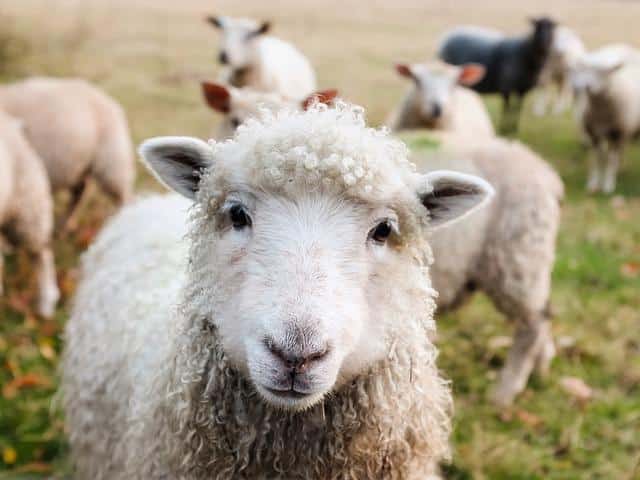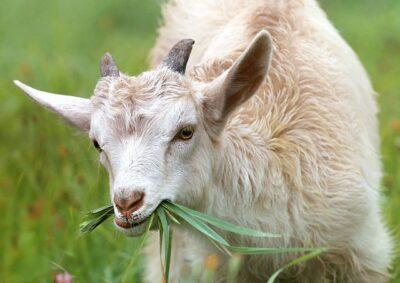I lived in ignorant bliss for years. Like many keepers of small ruminants up north, I was more complacent than I should have been about the possibility of parasites. As a general rule of thumb, these organisms have been more of a problem in southern locations for longer than they have in the north, but are gradually making their way to all regions of the country.
About six months after I purchased two doelings and integrated them into my herd, a visiting animal health expert noticed some worrisome symptoms in one of the young goats and took fecal samples back to her office to examine under a microscope. The next day, she called me with the results: the animal was loaded with barber pole worm.
I had never even heard of barber pole worms, and I set about learning all I could about it by asking other goat owners, seeking information from animal health experts, and searching online.
What Are They?
Barber pole worm, or Haemonchus contortus, is a parasitic organism which thrives in the abomasum—or last stomach—of ruminants. It is highly contagious, often deadly, and once contracted is nearly impossible to eradicate.
Research revealed that my first order of business was saving the life of my goat. How-to’s varied widely among all the sources I consulted, many of them directly contradicting one another on everything from types of medications to frequency and dosage. It was scary and confusing, to say the least.
Diatomaceous Earth: The All-Natural Livestock De-Wormer!
A person in my goat network took the time to tell me the story of what worked for her, and I believe her help is the reason my goat survived. She recommended I use a specific type of anthelmintic—the scientific term for a chemical de-wormer—called levamisole hydrochloride. The information I found online supported her advice. Levamisole is available only via mail order in my state, but the lady happened to have some on hand and offered it to me at her cost.
Lest the treatment described above sounds like a panacea, it most assuredly is not. Different drugs are more or less effective by region, by farm, by animal, and by a whole host of other factors. But if a treatment worked at a farm nearby, that is a good place to start.
Before continuing with information about barber pole worm, it is worth noting that I am not a veterinarian. Any knowledge I have of animal health and parasites is gained through my own research and experience as a goat owner, and should never be taken as advice in lieu of consulting an expert.
First, a few barber pole basics. It is the adult worms, striped like a barber pole, which take hold in the stomachs of ruminants. From there, they lay eggs which are passed out of the animal’s body through its feces. Once on the ground, the eggs develop into larvae and are ingested by ruminants as they graze. Back inside the digestive system, the larvae become adults and the life cycle continues.
Symptoms of Barber Pole Worm
Visible symptoms of the possible presence of barber pole worms include diarrhea, hanging tail, dull coat, lethargy and depression. It is important to remember that these signs can be indicative of other maladies, as well, so while these symptoms indicate that something is wrong, it is not always barber pole worm.
If barber pole worm progresses, edema—fluid buildup in body tissues—sometimes becomes visible, particularly in the face and jaw.
An excellent way to diagnose the presence of stomach worms—of which barber pole worm is a likely candidate—is by determining whether the animal is anemic. This can be achieved using a diagnostic tool called “FAMACHA.” This is basically a chart showing how to compare the colors of the tissue under the lower eyelids of the animal—pink tissue means there is plenty of healthy blood flow and white means anemic—and providing guidelines of when to treat.
“The Big Book Of Off The Grid Secrets” — Every Homesteader Needs A Copy!
Another excellent diagnostic method is a fecal exam. Veterinarians typically offer this service, but it can be costly and cumbersome for multiple animals and follow-ups. For this reason, many people learn to do it themselves. Examining fecal content is not nearly as off-putting as it sounds. Training can be attained for little or no money, often from another ruminant owner. My own microscope training was provided to me by the professor who first diagnosed my sick goat, but since that time my state cooperative extension has begun to offer quarterly microscope training workshops.
The expense of owning a good quality microscope can seem daunting, but groups and clubs can potentially share ownership in equipment, giving each member easy access without being solely responsible for cost or storage.
It is important to be aware that fecal exams do not always tell the full story. The presence of parasite eggs in fecal matter does not necessarily correspond exactly with the presence of adult stomach worms. When in doubt, always consult a veterinarian.
It is critical to catch barber pole early. Unchecked, it can be deadly. In late stages it is even possible for the treatment itself to be dangerous because the sudden die-off of parasites can render an animal too compromised to recover.
As with most things, an ounce of prevention is worth a pound of cure. It is wise to screen new animals for parasites before putting them in with your existing herd, even when buying high quality stock from a reputable dealer. Once barber pole was present on my farm, the only option from that point forward was to manage it.
Some livestock owners get desirable results by routinely administering anthelmintics to the entire herd or flock. However, current school of thought recommends treating only sick animals. The reason for this is to avoid the risk of creating a medication-resistant super-organism.
Hot to Prevent Barber Pole Worm
When my goat was first diagnosed, I treated my entire herd. It was important at that time to make a complete break in the life cycle of the parasite. I carefully monitored the fecal egg counts after the first dose and treated only sick animals from there on.
Parasite activity is minimal in winter in cold climates. It flares up most in spring and fall, so diligence is most crucial during those seasons. Some individual animals and certain breeds are naturally more resilient, and young stock is generally far more susceptible than are adults. Resilience—the innate ability to thrive in the presence of barber pole worm or avoid getting it at all—is an excellent trait to keep in mind when culling a herd.
Goofy Gadget Can Jump-Start Your Car — And Charge Your Smartphone!
Some of the best ways to manage barber pole worm are really more about managing the livestock, pasture and infrastructure. Parasite eggs and larvae thrive best in warm humid conditions, multiply most easily in crowded conditions, are most plentiful close to the ground, and have a more profound effect on less healthy animals. With those facts in mind, good parasite management includes:
- Keeping indoor quarters clean.
- Allowing ample space in the most-used paddocks.
- Rotating pastures and sticking to the highest and driest during damp seasons.
- Keeping hay and feed up off the ground by using hay and grain feeders.
- Hanging water buckets on walls to minimize spills and feces contamination.
- Keeping feed and water containers clean.
- Providing mid-level browse. Sheep tend to graze and goats prefer browse, but both will eat vegetation higher off the ground if browse is provided. This will help limit the likelihood of the larvae being ingested.
- Maintaining overall herd health.
- Staying abreast of any health changes in individual animals and within the overall herd, particularly during seasons when parasites are most prevalent.
- Doing fecal exams often.
- Being responsible regarding biosecurity: Use due diligence to prevent yourself and visitors from carrying barber pole worms to other farms.
Two other preventative treatments being increasingly recommended by veterinarians and farmers are copper and tannin. Many sheep and goat owners use copper boluses—capsules filled with copper pellets—as effective treatment. The drawback to these is that they can be challenging to administer, because they need to be shot with a special gun down the animal’s gullet in order to remain intact and not chewed. An easier yet arguably less effective method is to offer free-choice tannin. This is easily found in the bark of softwood trees, but comes with a warning: certain pine trees are toxic to goats and sheep. Pine trees native to my region pose no danger, but that is not the case in all areas of the country. The bark of other trees, most notably cherry, can be toxic, as well. If you are not certain, consult your veterinarian.
No small ruminant farmer wants to have barber pole worm show up in his or her herd, but it is becoming increasingly common in most areas. But with attention to self-education and adoption of careful practices, barber pole worm can be monitored, managed and mitigated.
Have your sheep or goats ever had barber pole worm? Share your advice in the section below:
Discover The Secret To Saving Thousands At The Grocery Store. Read More Here.
 Off The Grid News Better Ideas For Off The Grid Living
Off The Grid News Better Ideas For Off The Grid Living






